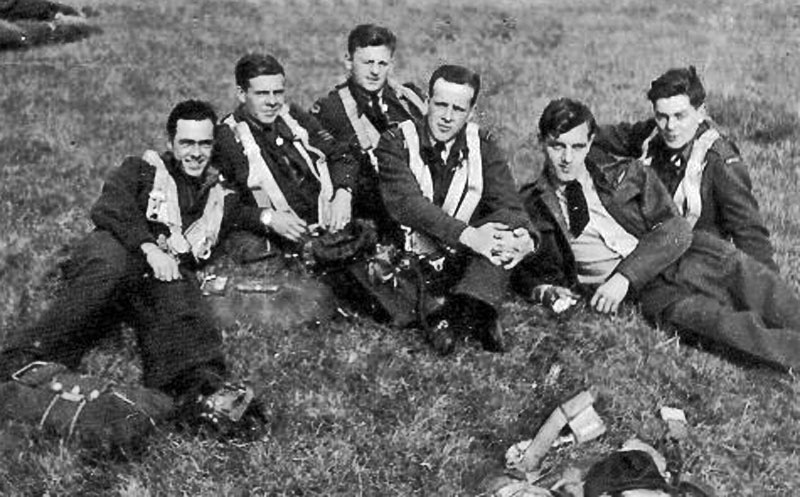During the evening of 15th January 1945 the crew of this 1659 Heavy Conversion Unit aircraft were briefed with undertaking a series of basic training flights called a "circuits and landings" exercise. This involved taking off, flying a circuit of the airfield and landing, applying full power then taking off again and continuing this pattern a number of times. This series of short flights was the first part of flying together the trainees undertook at Heavy Conversion Units after the pilot was allowed to fly without an instructor. It allowed the pilot and flight engineer to get experience in taking off and landing the aircraft before continuing with other aspects of the Heavy Conversion Unit training program.
On this date a usual seven-man Halifax crew had been joined with a pilot and flight engineer from another trainee crew and they begun the series of circuits and landings in Halifax LK871. During the first take off run at Topcliffe airfield the aircraft swung to starboard which the pilot managed to correct and the aircraft took off. The crew made the circuit and touched down at Topcliffe at 18.50hrs. As power was applied for the second take off the same thing happened and it swung again to starboard but before it could be corrected the starboard main wheel ran off the edge of the runway. The port tyre then burst and the aircraft ground looped causing the port undercarriage to collapse. At the time of this accident the pilot (F/O Mooney) had only gained twenty minutes solo flying at night in the Halifax all of which was probably gained on this date. Halifax LK871 sustained repairable Cat.A(c) damage. The two engines on the port side were damaged while the ones on the starboard side did not hit the ground and were undamaged. The nine airmen involved in this mishap were new to flying the Halifax and it was almost certainly the pilot's first experience of the effects of a swinging aircraft. The crew were not medically examined and two hours later were ordered to undertake the same circuits and landings exercise in a fresh aircraft, Halifax LK878. As it turned out not being medically examined was a factor in their second incident in the night. At 20.55hrs the same nine airmen (standard crew of seven plus two of another crew) took off from Topcliffe just before 21.00hrs and soon after taking off the starboard outer engine failed. This probably resulted in the inexpereienced pilot finding that he could not get the aircraft to climb as would be needed to avoid rising ground around a third of the way around the airfield. The aircraft first struck the ground in a snow-covered field near the small village of Felixkirk, bounced across a narrow lane and into an area of woodland and broke up. Local people were soon on the scene having heard the crash but sadly eight of the nine airmen on board were beyond help and sadly died in the crash, they found a seriously injured airman who was dragged clear, it is possible that the rear turret broke off in the initial impact as this airman was the rear gunner. He was initially placed into a private car with the intention of taking him to hospital though it seems likely that the deep snow put paid to driving him to hospital. Further information is gained from the record book of Northallerton Military Hospital which stated that at 22.15hrs the "Mobile Surgical unit proceeded to Felixkirk at the request of RCAF Topcliffe." The injured airman was removed from the car and transferred to the ambulance. "He was in a very poor condition and died immediately after admission to hospital (at Northallerton) from multiple injuries". The Humber (vehicle) had to be abandoned half a mile from the scene of the crash owing to deep snow. Personnel walked through the snow to the crash. The surgical unit returned to Northallerton at 00.15hrs".
The crash investigators concluded that a major factor in the crash occuring was down to the crew having not been medically examined to see if they were fit to fly the second exercise that night. The officer in charge of flying control was later relieved of his duties and other less senior members of flying control had their responsibilities reduced. The Commanding Officer of 1659 HCU returned to Canada in the weeks after this accident and one wonders whether it had something to do with the outcome of the investigation.

A photograph of six of the complete seven man crew involved in this accident. Left to right, McGregor, Stavenow, MacDonell, Mooney, Savy & McCrea. Photographs of the extra pilot and flight engineer are included on their seperate biographies linked below.